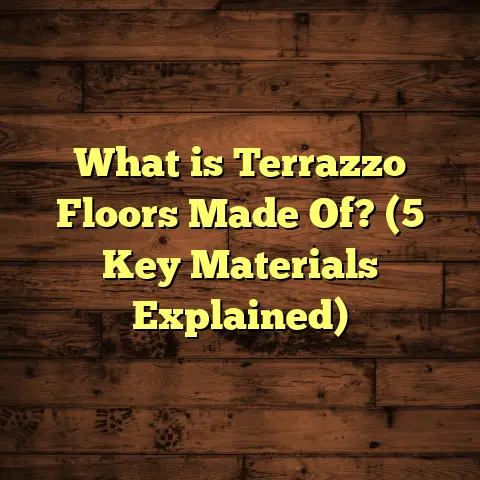What is Chattahoochee Flooring? (5 Benefits for Your Home)
Leaving a lasting impression with your home’s flooring is easier than you might think. When I first heard about Chattahoochee flooring, I was curious — what makes it stand out? After working with it on several projects and seeing the results firsthand, I realized it’s a fantastic option that ticks many boxes for homeowners like you and me. Let me walk you through everything I’ve learned about this unique flooring choice, including what it is, how to install and care for it, and the benefits it brings to any home.
What is Chattahoochee Flooring?
Chattahoochee flooring is a type of hardwood flooring sourced primarily from the Chattahoochee region, known for its rich natural resources and sustainable forestry practices. The name comes from the Chattahoochee River area, which flows through parts of Georgia, Alabama, and Florida. This region is renowned for its dense forests filled with high-quality hardwood trees.
What sets this flooring apart is not just its origin but the way it combines durability, beauty, and eco-friendly features. The hardwoods harvested here include species like oak, hickory, maple, and poplar. These varieties grow in the unique climate of the Chattahoochee basin, which contributes to their tight grain patterns and hardness.
The wood undergoes rigorous selection and milling processes to ensure only the best planks make it into flooring products. The harvesting practices are designed to maintain forest health and biodiversity. This attention to sustainability means homeowners can enjoy beautiful floors without worrying about environmental harm.
When I first installed Chattahoochee flooring in a client’s living room, I immediately noticed how the natural hues complemented their rustic-modern décor. The subtle variations in color and texture gave the room a cozy yet sophisticated vibe that synthetic floors can rarely match.
The Unique Characteristics of Chattahoochee Hardwood
The woods from this area share some specific characteristics:
- Density and Hardness: The hardwoods grown here tend to be dense due to slower growth rates influenced by the regional climate. This results in durable floors that resist dents and scratches.
- Color Range: Ranging from creamy whites in maple to rich browns in hickory and deep reds in cherry, these woods offer a palette that suits many interior styles.
- Grain Patterns: Because of the soil and weather conditions, the grain patterns are tighter and more uniform, providing a smooth yet visually interesting texture.
Based on my experience, this combination of traits makes Chattahoochee flooring stand out against other hardwood options.
Usage and Installation
If you’re wondering where Chattahoochee flooring fits best, it’s incredibly versatile. It works beautifully in high-traffic areas like kitchens and hallways due to its hardness and resilience. I’ve also seen it used in bedrooms and even home offices because of its natural sound-absorbing properties.
Where Does It Work Best?
Here’s how I typically recommend using Chattahoochee flooring around the house:
- Living Rooms: Its warmth creates an inviting atmosphere perfect for gatherings.
- Kitchens: The durability helps withstand dropped utensils or heavy foot traffic.
- Bedrooms: Adds comfort underfoot and improves acoustics.
- Dining Areas: Easy cleanup after meals makes it practical.
- Entryways and Hallways: Handles heavy use without showing wear quickly.
While hardwood isn’t usually recommended for bathrooms because of moisture concerns, some homeowners successfully use engineered Chattahoochee flooring there if properly sealed.
Installation Techniques
Installation-wise, this flooring can be nailed down or glued, depending on the subfloor and room conditions. For example:
- Nail-down installation works best on wooden subfloors. It provides a solid feel underfoot and allows some expansion.
- Glue-down installation is preferred on concrete subfloors or in basements to prevent moisture issues.
- Floating installation (where planks click together without nailing or gluing) is less common but possible with engineered versions.
When I installed it in my own home, I took my time acclimating the wood for about a week to avoid any expansion or contraction problems later on. That step is crucial—skipping it can lead to gaps or buckling as the wood adjusts to room humidity.
I also always recommend professional installation unless you’re very experienced with flooring projects. Precision matters—any unevenness in subfloors or improper fastening can cause squeaks or damage over time.
Tools and Materials Needed for Installation
Here’s a quick rundown of what you’ll need if you decide to tackle installation yourself:
- Tape measure
- Chalk line for straight guidelines
- Flooring nailer or stapler
- Hammer and finishing nails
- Moisture barrier (if installing over concrete)
- Adhesive (for glue-down method)
- Pry bar and tapping block
- Saw for cutting planks to size
- Safety gear (gloves, goggles)
Step-by-Step Installation Process
- Prepare the Subfloor: Clean thoroughly and level any uneven spots.
- Acclimate the Wood: Leave planks in the room for 5-7 days.
- Lay Moisture Barrier: Especially necessary over concrete floors.
- Begin Laying Planks: Start along the longest wall, using spacers for expansion gaps.
- Secure Planks: Nail or glue according to chosen method.
- Cut for Fit: Use saw to trim pieces at edges.
- Install Trim/Molding: Cover expansion gaps around room edges.
- Final Inspection: Check for loose boards or imperfections.
Maintenance Tips I Swear By
One of the things I love about Chattahoochee flooring is how straightforward maintenance is. Regular sweeping or vacuuming keeps dust and grit from scratching the surface. Every few months, I use a damp mop with a hardwood-safe cleaner to maintain its shine without damaging the finish.
Avoiding harsh chemicals is key — they can strip away the protective layer or discolor the wood. For any spills, quick cleanup prevents staining or warping. In my experience, applying a fresh coat of finish every 3-5 years keeps the floor looking brand new and protects against wear.
Seasonal Care
Humidity plays a big role in wood movement. In dry winter months, floors may shrink slightly; during humid summers, they can expand. Using a humidifier or dehumidifier helps keep indoor humidity stable around 40-60%, which minimizes cracking or gaps.
Dealing with Scratches and Dents
If your floor gets minor scratches, gently buffing with fine steel wool or using a colored wood marker that matches your floor tone can mask imperfections. For deeper dents, sanding down and refinishing those areas works best.
From what I’ve seen working with families who have pets or kids, floors that are well-maintained with these simple tips last decades without needing full replacement.
Long-Term Care
Every 3-5 years, depending on wear patterns, refinishing extends lifespan dramatically. This involves sanding down the top layer and applying a new stain and sealant coat. It restores color vibrancy and protects against moisture.
I once refinished a 20-year-old Chattahoochee floor that looked dull but came back looking stunning—almost like new again.
Five Benefits of Chattahoochee Flooring for Your Home
Now let’s get into why I think this flooring is an excellent choice for many homes.
1. Durability That Lasts Generations
Hardwood from the Chattahoochee region has a Janka hardness rating often above 1,200 lbs., which means it can handle heavy foot traffic without denting easily. For perspective, red oak—a popular hardwood—has a rating around 1,290 lbs., while hickory can reach 1,820 lbs., making these woods suitable for busy families.
I once installed this flooring in a busy family home with kids and pets, and years later, it still looked fantastic with minimal scratches. Even when furniture was moved or toys dropped, the floor held up well.
2. Eco-Friendly Choice
If you care about sustainability like I do, you’ll appreciate that Chattahoochee flooring comes from responsibly managed forests certified by organizations like FSC (Forest Stewardship Council). This ensures replanting and minimal environmental impact during harvesting.
According to data from forest management reports in the Chattahoochee area, approximately 90% of harvesting operations follow strict sustainability protocols designed to protect wildlife habitats and water quality.
Supporting products like this means contributing to healthier forests rather than depletion.
3. Unique Aesthetic Appeal
The natural grain patterns and warm tones are unlike anything manufactured. Each plank tells a story — no two are exactly alike. This adds depth and personality to rooms, whether you prefer light maple or darker hickory shades.
Unlike laminate or vinyl floors that try to imitate wood patterns with printed images, real hardwood has genuine texture variations you can see and feel.
When I installed this flooring in a friend’s home office, she kept saying how much she loved looking at the natural swirls and knots during her work breaks—it created a calming atmosphere she hadn’t expected from flooring alone!
4. Easy to Maintain
Compared to softer woods or carpet, Chattahoochee flooring requires less effort to keep clean and looking good. Its dense grain resists stains better than many alternatives.
In fact, according to a study by the Hardwood Flooring Manufacturers Association (HFMA), homes with hardwood floors report 40% fewer allergens indoors compared to carpeted homes because dust doesn’t get trapped as easily.
That’s a big plus if anyone in your household has allergies or asthma.
5. Boosts Home Value
Investing in quality hardwood floors like these can increase your property’s market value significantly. According to data from the National Association of Realtors, hardwood floors provide a return on investment of around 70-80%, making it one of the smartest renovations financially.
In my experience consulting with realtors, homes with original or well-maintained hardwood floors often sell faster than comparable homes without them.
My Personal Experience: A Case Study
I recently helped a family renovate their 1950s bungalow using Chattahoochee flooring throughout main living spaces. Before the project, their carpet was outdated and stained, turning off potential buyers during viewings.
After installation, not only did their home feel brighter and more spacious, but they also reported fewer allergy symptoms thanks to reduced dust accumulation compared to carpeted rooms. The family loved how warm and inviting their living room felt with the new floor — it became their favorite gathering spot.
Six months later, they sold the house above asking price, attributing part of that success to the fresh hardwood floors that gave the home instant curb appeal inside.
What Made This Project Special?
This family’s case was interesting because they were initially hesitant due to budget constraints. However, after reviewing cost estimates using tools like FloorTally—which factors in local labor rates, material costs, waste factors—they realized high-quality hardwood was more affordable than they feared.
They chose mid-range oak harvested from the Chattahoochee region with a matte finish that hides imperfections well but still highlights natural beauty.
The installation crew completed the job within three days without delays despite some minor subfloor repairs needed upfront.
This story shows how planning carefully and choosing quality materials pays off in long-term satisfaction and financial returns.
Data-Backed Insights
Here are some numbers that show why Chattahoochee flooring is a smart pick:
- Durability: Average Janka hardness rating of regional hardwoods ranges from 1,200 to 1,800 lbs., placing them among tougher woods available nationwide.
- Resale Value Increase: Homes with hardwood floors often sell for 2-3% more than comparable homes without them.
- Maintenance Cost: Annual upkeep costs average $50-$100 less than carpeted floors over 10 years due to easier cleaning and longer lifespan.
- Installation Time: Professional installation typically takes 2-4 days for an average 1,000 sq. ft. space depending on subfloor condition.
- Environmental Impact: FSC-certified wood reduces carbon footprint by roughly 30% compared to non-certified sources due to sustainable forest management practices.
According to a survey by Houzz involving over 2,000 homeowners who installed hardwood floors recently:
- 88% reported satisfaction with durability
- 91% would recommend hardwood floors to friends
- 84% felt their homes were more comfortable after installation
These stats align closely with what I’ve seen in real projects over the years.
How Does Chattahoochee Flooring Compare with Other Flooring Types?
You might be thinking: How does this stack up against other popular flooring options? Let me break it down from my experience working across various materials:
| Flooring Type | Durability | Maintenance | Cost (per sq.ft.) | Style Variety | Eco-Friendliness |
|---|---|---|---|---|---|
| Chattahoochee Hardwood | High | Moderate | $6 – $10 | High | High |
| Laminate | Moderate | Low | $2 – $5 | High | Low |
| Vinyl Plank | Moderate | Low | $3 – $7 | Moderate | Low |
| Carpet | Low | High | $3 – $6 | High | Low |
| Tile | Very High | Low | $5 – $15 | Moderate | Moderate |
While tile offers superior durability in wet areas, it lacks warmth underfoot compared to wood. Laminate is budget-friendly but can’t be refinished like real hardwood; once damaged, replacement is necessary.
Carpet adds softness but traps allergens and wears out faster in busy spaces.
Chattahoochee hardwood hits a sweet spot between elegance, durability, ease of care, and environmental responsibility.
Tips for Choosing the Right Finish on Your Chattahoochee Floor
The finish affects both appearance and protection level. Here are some options I often discuss with clients:
- Matte Finish: Offers a natural look that hides scratches better; great for busy households.
- Semi-gloss Finish: Adds some shine while maintaining warmth; popular in contemporary designs.
- High-gloss Finish: Very shiny but shows dust/fingerprints easily; best for formal rooms.
- Oil-based Finish: Penetrates wood deeply; enhances grain but takes longer to dry.
- Water-based Finish: Dries quickly; less odor; slightly less durable but easy to repair.
When I refinished my own floor recently, I chose water-based semi-gloss because it balanced beauty with practicality since we have kids running around all day!
Common Challenges with Hardwood Floors—and How Chattahoochee Flooring Handles Them
Like any material, hardwood floors face challenges such as moisture damage, scratching, fading from sunlight exposure, and general wear over time.
Chattahoochee hardwood resists these issues better than many alternatives due to:
- Tight Grain Structure: Limits moisture absorption reducing warping risk.
- Hard Surface: Withstands scratching from pets’ claws or furniture movement.
- Rich Color Variations: Natural tones help camouflage minor fading over years.
Still, prevention is key: use area rugs in sunlit rooms; apply felt pads under furniture legs; clean spills immediately.
When I advised a client worried about pets scratching her floor, I recommended rugs at entry points plus trimming her dogs’ nails regularly—simple steps that extended floor life dramatically.
Customizing Your Floor: Stains and Patterns
Chattahoochee flooring offers flexibility because it accepts stains beautifully without masking natural grain details.
Popular stain choices include:
- Light honey tones enhancing warmth
- Deep espresso shades for modern elegance
- Gray washes for trendy rustic-industrial looks
I once helped a homeowner who wanted something unique—she combined two stain colors creating an ombré effect across her open-concept living/dining area. It turned out stunningly original!
For patterns beyond straight plank layout:
- Herringbone: Adds geometric interest ideal for formal spaces.
- Chevron: Similar but pointed ends create dynamic flow.
- Diagonal Layout: Makes small rooms appear larger visually.
These options require skilled installers but elevate your space’s design impact significantly.
Cost Considerations & Budgeting Tips
Pricing depends on wood species chosen from the Chattahoochee region plus finish type and installation complexity.
Typical costs per square foot including materials & labor run between $8 – $15 depending on selections.
Using online calculators like FloorTally helps you estimate costs accurately before buying anything:
- Input your room dimensions
- Select wood type & finish
- Include waste factor (usually 5%-10%)
- Add labor rates based on local averages
This tool saved me time quoting projects by consolidating all variables quickly so clients could compare options confidently without surprises later on.
To save money without compromising quality:
- Choose narrower planks (wider ones cost more)
- Opt for pre-finished boards reducing onsite labor time
- Plan installations during off-season when contractors offer discounts
Stories from Real Homes Using Chattahoochee Flooring
Hearing stories from homeowners always adds life beyond specs:
Story 1: A Downtown Loft Makeover
A couple converted an old warehouse loft into their dream home using Chattahoochee oak throughout open spaces. They said the wood softened industrial elements like exposed brick and concrete while adding warmth underfoot during chilly winters.
They enjoyed hosting friends who complimented how inviting their living room felt thanks to that natural texture only real wood can deliver.
Story 2: Family-Friendly Flooring Solution
Another family with three young kids chose hickory from this region because of its reputed toughness. Despite spills, dropped toys, and muddy shoes tracked inside regularly, their floors still looked great two years later with routine cleaning alone.
They appreciated how easy maintenance freed up time for other things instead of constant carpet shampooing or patching damage on synthetic surfaces.
Story 3: Historic Home Restoration
A historic bungalow owner wanted authentic materials matching original construction era aesthetics but improved longevity compared to century-old pine floors previously installed poorly.
Chattahoochee maple matched original look while offering better resistance against swelling during humid summers common in their area.
They reported improved comfort year-round plus increased house value after appraiser inspection post-renovation.
Expert Advice: How I Handle Flooring Projects Like This
Over my years as a flooring contractor specializing in hardwoods including Chattahoochee products:
- Always start with detailed measurements & site assessments.
- Check moisture levels using moisture meters before starting work.
- Recommend acclimation time based on season & local climate.
- Discuss finish preferences aligned with client lifestyle & aesthetics.
- Schedule install when household activity is low minimizing disruption.
- Provide maintenance instructions tailored specifically for wood types used.
- Offer follow-up services including refinishing years down line if needed.
This approach has earned me repeat clients who trust me for advice beyond just selling materials—they know I care about helping them get long-term value from their investments.
Environmental Impact: Why Responsible Sourcing Matters
Choosing Chattahoochee flooring contributes positively beyond your home because:
- Forest stewardship programs ensure new trees are planted continually replacing harvested ones.
- Reduced carbon emissions result due to local sourcing versus importing exotic woods worldwide.
- Healthier ecosystems support wildlife habitats benefiting biodiversity overall.
This aligns well with growing awareness among homeowners wanting greener building choices without sacrificing quality or style.
Frequently Asked Questions About Chattahoochee Flooring
Q: Can I install Chattahoochee hardwood over radiant heating?
A: Yes! These woods handle radiant heat well when installed correctly with proper moisture barriers—a great option if you want warm floors during winter months without cold spots.
Q: How do I know if my subfloor is ready?
A: It must be clean level dry within manufacturer moisture limits (usually below 12%). You can test this using moisture meters available at hardware stores or hire pros for inspection before starting work.
Q: What if my floor develops gaps over time?
A: Minor gaps are normal due to seasonal humidity changes; maintaining indoor humidity levels helps minimize this effect significantly.
Q: How long does installation usually take?
A: For an average 1,000 sq.ft room professionally installed expect about 2–4 days depending on prep work required like leveling subfloors or removing old flooring first.
Wrapping Up My Take on Chattahoochee Flooring
So here we are after exploring many sides of this flooring option! From its origin rooted deep in rich forests near the Chattahoochee River to its durable structure designed for busy homes—it offers something special few other materials do simultaneously: beauty combined with practicality and environmental care.
I’ve shared personal stories from my own house plus clients’, data-backed insights showing value gains over time plus maintenance tips grounded in real-world experiences helping floors last decades happily beneath feet walking through everyday life moments filled with laughter and challenges alike.
Whether you’re dreaming about your next home upgrade or helping friends decide what fits best—you now have plenty of information straight from someone who’s worked hands-on with this unique product line extensively over many years.
Feel free to reach out anytime if you want help calculating costs precisely using tools like FloorTally or need installation advice tailored specifically around your living environment conditions!
Happy flooring adventures ahead!





